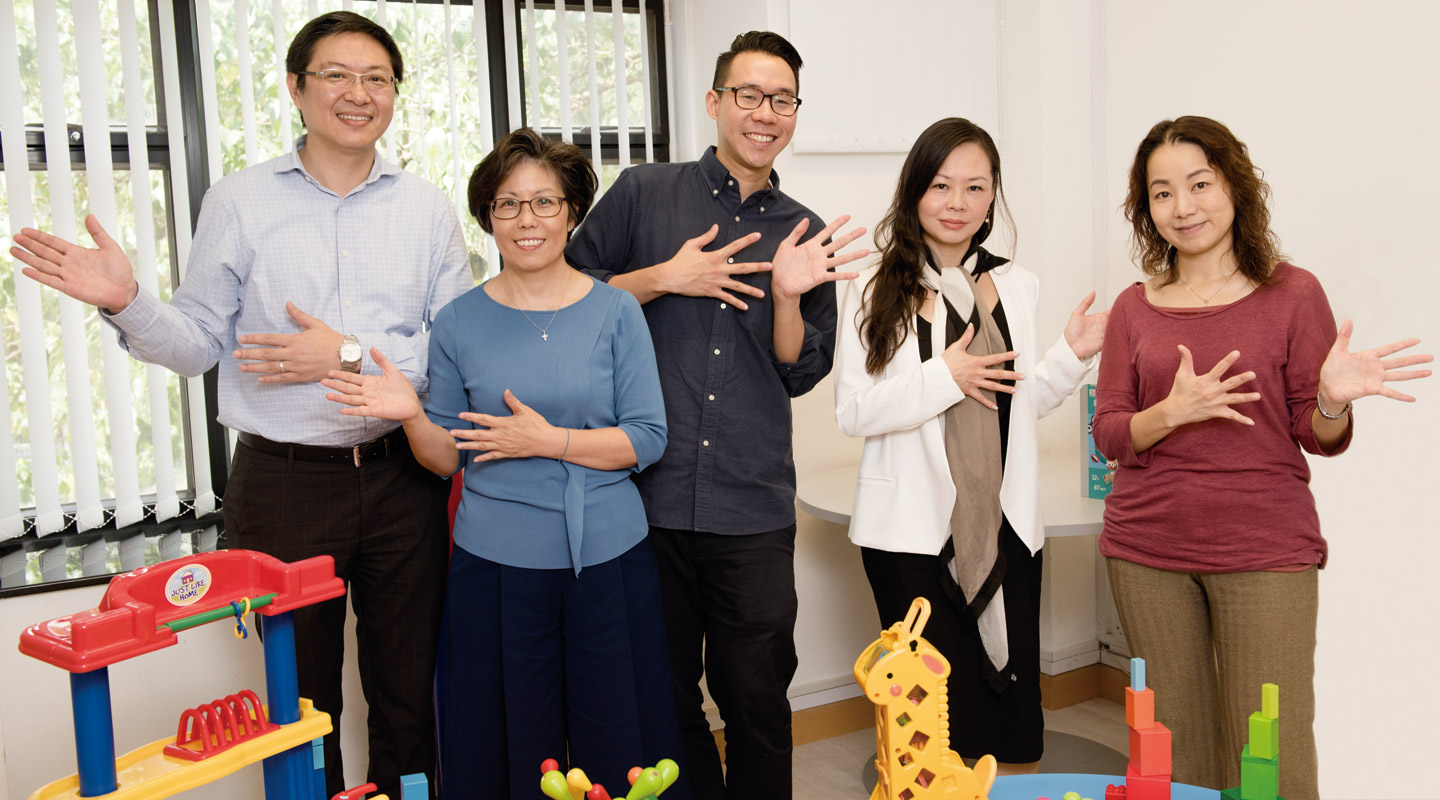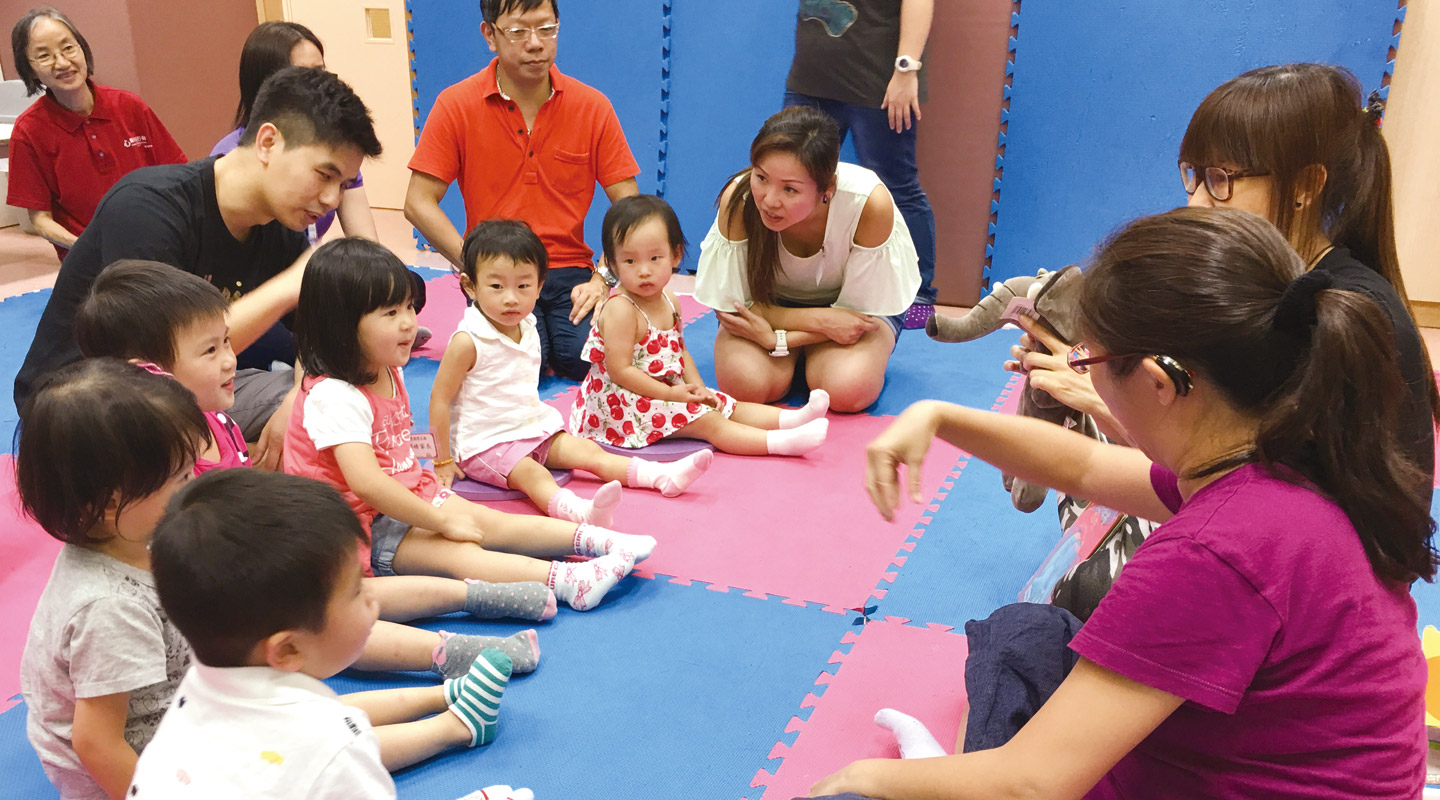Dear readers, With the launch of e-newsletter CUHK in Focus, CUHKUPDates has retired and this site will no longer be updated. To stay abreast of the University’s latest news, please go to https://focus.cuhk.edu.hk. Thank you.
Raising Sign Bilingual Children
Gladys Tang advocates sign language for everyone

Sign language was developed to cater to the communicative needs of deaf people. Surprisingly, among the 150,000 deaf and hard-of-hearing individuals in Hong Kong, fewer than 4,000 of them are competent in signing. It is due to a common misconception that learning sign language will impede oral language development. For fear of making it harder for the group to live a normal life, deaf education in Hong Kong had avoided sign language like the plague. It was not until 2006, when Prof. Gladys Tang of CUHK’s Department of Linguistics and Modern Languages rolled out the Sign Bilingualism and Co-enrolment in Deaf Education Programme (SLCO Programme), that such myth began to fall apart.
The SLCO Programme, now in its 10th year, has taken roots in mainstream schools from kindergarten to secondary school level, where deaf and hearing students are colearning in a sign bilingual environment. Earlier this year, having received a funding of HK$400,000 from the Sustainable Knowledge Transfer Project Fund administered by the Office of Research and Knowledge Transfer Services (ORKTS), Professor Tang and her team at the Centre for Sign Linguistics and Deaf Studies started up SLCO Community Resources Limited, a social enterprise expected to open in 2017, to extend sign bilingual education to a wider public, initially targeting the newly born up to the age of three and their parents.
‘From the linguistic perspective, the first three to five years since birth are most vital for language acquisition, including sign language. As the SLCO Programme only starts from kindergarten onwards and those aged below three need support services as well, SLCO Community Resources is hence set up to close this service gap in supporting children’s development in the early years,’ said Professor Tang.
A Different Form of Bilingualism
Learning to speak is a daunting task for people with hearing loss. Recent sign linguistic research has shown that, contrary to popular belief, sign language does not jeopardize but facilitate speech development. ‘As a visual-spatial language, sign language is barrier-free for deaf children in terms of acquiring linguistic knowledge. Sign bilingualism supports the acquisition of not only sign but also spoken language. With a strong linguistic foundation and the flexibility of choosing between spoken and sign language in their daily communication, deaf children will enjoy equal opportunities for education with their hearing peers,’ explained Professor Tang.
‘For children with profound hearing impairment, hearing aids are not of much help. Some six-year-old deaf kids only achieve the language ability of a one/two-year-old. How are they supposed to survive in a normal classroom setting? In contrast, deaf children raised in a bimodal bilingual, mainstream learning environment get along well with their classmates; they have no trouble communicating with their hearing and deaf peers,’ added Chris Yiu, senior programme officer of the Centre.
Benefits of a Bilingual Brain
SLCO Community Resources targets not only deaf but also hearing children. When asked about the benefits of learning sign language for the hearing population, Prof. Tang answered: ‘Recent studies from abroad have shown that sign bilingualism spurs brain development. Signing stimulates areas of the left hemisphere of the brain responsible for language processing and logical thinking. Additionally, it activates the occipital lobe for vision, the parietal lobe for spatial relationships and the frontal lobe for voluntary motions. No one deaf or hearing, would say no to better brain activation. Learning sign language not only expands one’s linguistic knowledge but also boosts other functionalities of the brain.’
Kelly Kwan, research instructional officer of the Centre, pointed out that if babies under the age of three learn sign language with their families, it gives them a head start on parent-child communication. ‘Infants as young as nine months can begin to use basic signs covering objects such as “apple”, “flower”, “car” and concepts such as “I want” and “I don’t like” which normal children aren’t able to articulate until they are over 12 months of age. The earlier the babies are able to communicate well with their parents, the better their well-being. Parents are also happy to have a better idea of their babies’ needs and wishes before the onset of speech.’
Research assistant Raymond Wong added, ‘The new generation of parents are eager to explore all sorts of ways to improve their children’s development, and sign language for babies has caught the young parents’ attention in recent years. The Centre has been receiving enquires regarding baby signing courses, most of which from parents of hearing infants. It speaks of an improved public understanding of sign language, which bodes well for the future of SLCO Community Resources.’

Staunch Supporters
Bankroll aside, ORKTS also found the SLCO team a business consultant──Elsie Tsui of CUHK’s Center for Entrepreneurship──to advise on the managing of this social enterprise. ‘If sign language is only meant for deaf people, the market size will be too small. But when I heard of the many benefits of learning sign language for hearing people, I knew SLCO Community Resources could play a bigger role. I believe this project has potential to attract the interest of parents in general, so I support the SLCO team to develop a viable business model for this meaningful project.’ said Elsie.
Professor Tang expressed deep gratitude for all ORKTS has done to help her team translate their research findings into concrete social impact. ‘The success of sign linguistics does not only hinge upon the number of publications, but also on whether this discipline will change the fate of the deaf and the attitude of the hearing towards deafness and sign language. SLCO Community Resources is set to enhance deaf children’s language and academic skills, as well as to nurture a group of sign bilingual hearing children with an inclusive attitude. Both of them will form an inclusive community, which drives the development of a much more inclusive world at large,’ said Professor Tang.
This article was originally published in No. 487, Newsletter in Nov 2016.
Read More: